Click on images to enlarge
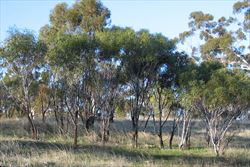
infestation (Photo: Bruce Maslin)
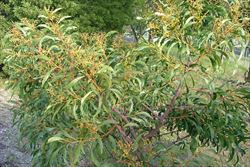
habit of a young tree (Photo: Sheldon Navie)
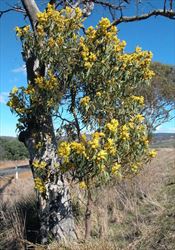
habit of young tree in flower (Photo: Greg Jordan)
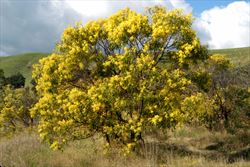
habit of large tree in flower (Photo: Bruce Maslin)
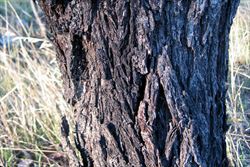
trunk of mature tree with rough bark (Photo: Bruce Maslin)
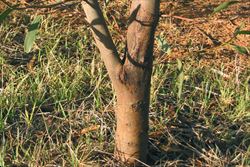
trunk of young tree with smooth bark (Photo: Bruce Maslin)
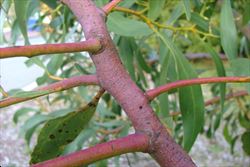
younger branches with smooth reddish coloured bark (Photo: Sheldon Navie)
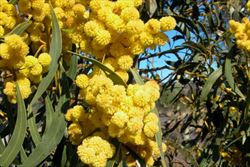
close-up of the globular flower clusters (Photo: Greg Jordan)
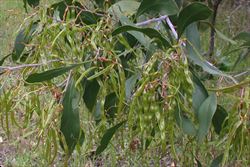
immature fruit (Photo: Rob and Fiona Richardson)
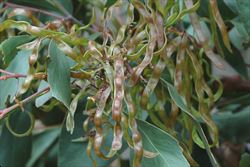
close-up of immature fruit (Photo: Rob and Fiona Richardson)

close-up of seeds with small fleshy arils (Photo: Steve Hurst at USDA PLANTS Database)
Scientific Name
Acacia pycnantha Benth.
Synonyms
Acacia falcinella Meisn.Acacia leiophylla Benth. (misapplied)Acacia petiolaris Lehm.Acacia pycnantha Benth. var. pycnanthaAcacia pycnantha Benth var. petiolaris H. Vilm.Acacia westoni Maiden, orth. var.Acacia westonii MaidenRacosperma pycnanthum (Benth.) Pedley
Family
Fabaceae: sub-family Mimosoideae (New South Wales)Leguminosae (South Australia)Mimosaceae (Queensland, the ACT, Victoria, Tasmania, Western Australia and the Northern Territory)
Common Names
Australian golden wattle, blackwood, broad leaved wattle, broadleaf wattle, broad-leaved wattle, golden wattle, green wattle
Origin
Golden wattle (Acacia pycnantha) is native to large parts of south-eastern Australia and is the official floral emblem of Australia. It is widespread and often locally common in Victoria and extends west into many parts of South Australia, including the Yorke Peninsula, the southern Eyre Peninsula, Kangaroo Island and the areas south-east of the Flinders Range. There are also isolated natural occurrences of this species in the inland parts of southern New South Wales and near Canberra in the ACT.
Cultivation
This species has been widely planted as an ornamental, particularly in the southern parts of Australia, because of its profusion of fragrant golden-yellow flowers.
A variant of this species with drooping (i.e. pendulous) branches and another variant with pale-coloured flowers are also known in cultivation. In addition, a garden hybrid of this species and Queensland silver wattle (Acacia podalyriifolia), called Acacia x siebertiana L. Winter ex A. Berger, has also been developed overseas.
Naturalised Distribution
This species is naturalised in south-western and southern Western Australia and in eastern Tasmania. It is also naturalised beyond its native range in some parts of northern and central New South Wales.
Golden wattle (Acacia pycnantha) is most widely naturalised in Western Australia, where it is most common throughout the western wheatbelt and in the Darling Ranges from Perth to Albany. However, it has also been recorded further east near Esperance and inland near Kalgoorlie. In New South Wales it has been extensively cultivated beyond its native range and has been recorded as naturalised in several areas of the state. However, it is most commonly naturalised near Sydney in the coastal districts of central New South Wales.
This species has also become naturalised in many other parts of the world, where it has been widely cultivated. Records exist from southern Africa (i.e. South Africa and Tanzania), New Zealand, Asia (i.e. India and Indonesia), Europe (i.e. Italy, Portugal and Sardinia), and the western parts of the USA (i.e. California).
Habitat
This species grows naturally in dry sclerophyll forests, open woodlands, shrublands, heathlands and grasslands. It is mainly found growing in sandy and stony soils, but also occurs in red loams.
Where golden wattle (Acacia pycnantha) has become naturalised beyond its native range in Australia, it is most frequently found growing along roadsides and in nearby woodlands. In Tasmania it grows in sandy coastal sites and in drier areas in the north-east of the state.
In South Africa it grows in coastal and highland regions, and is most commonly found in fynbos shrublands, along waterways, and on roadsides.
Habit
A rather short-lived large shrub or small tree usually growing 3-8 m tall with an upright and spreading habit. However, this is a somewhat variable species and small, spindly forms sometimes occur that flower when only 0.5-1 m high.
Distinguishing Features
- a shrub or small tree with simple 'leaves' that are bright green or dull green in colour.
- its younger branches and 'leaves' are somewhat drooping in nature.
- its 'leaves' (6-20 cm long and 5-50 mm wide) are leathery and sickle-shaped (i.e. they resemble eucalypt leaves).
- its golden-yellow flowers borne in small globular clusters (6-10 mm across) that are arranged into larger elongated compound clusters.
- its elongated and somewhat flattened pods (50-140 mm long and 5-8 mm wide) are sometimes slightly constricted between each of the seeds.
Stems and Leaves
The bark on the main stem (i.e. trunk) is smooth or only finely fissured and dark brown to greyish in colour. Younger branches are hairless (i.e. glabrous), either rounded or angled in nature, and often have a drooping appearance (i.e. they are pendulous). These younger branches are usually green in colour, but may sometimes be thinly covered in a whitish powdery substance (i.e. they may be pruinose or slightly glaucous). The younger stems may develop rounded knobbly outgrowths (i.e. galls), which are caused by a species of wasp.
The 'leaves' of this plant are actually flattened and widened leaf stalks (i.e. petioles), and not leaves in the true sense of the word. These modified leaf stalks are called phyllodes, but serve the same function as a regular leaf. On very young plants, partially formed phyllodes can be seen which bear twice-compound (i.e. bipinnate) leaves at their tips. As the seedling grows, each new 'leaf' has phyllodes that are more fully formed and the leaves at their tips become reduced and eventually vanish altogether. The phyllodes are alternately arranged along the stems, have a drooping appearance (i.e. they are pendulous), and closely resemble eucalypt leaves. They are relatively broad to elongated in shape (i.e. elliptic to oblanceolate) and usually somewhat sickle-shaped in nature (i.e. falcate or sub-falcate). These phyllodes (6-20 cm long and 5-50 mm wide) are hairless (i.e. glabrous) and relatively thick and leathery in nature. They are also somewhat shiny in appearance and either bright green or dull green in colour. Each phyllode has a single prominent vein running lengthwise down its centre (i.e. a midrib) and has slightly raised margins. They often have asymmetric bases (i.e. one side of the midrib is broader than the other) and have rounded to pointed tips (i.e. acute to obtuse apices). At the base of each of the phyllodes there is a short thickened structure (4-7 mm long) that resembles a leaf stalk (i.e. pulvinus). On the upper margin of the phyllode there are one or two small raised structures (i.e. glands), the lowest of these being between 3-45 mm above its base.
Flowers and Fruit
The small yellow or golden-yellow flowers are fluffy in appearance due to the presence of numerous stamens. They have five relatively inconspicuous petals and sepals and are densely arranged into small globular clusters (6-10 mm across). The small globular flower clusters each contain 40-100 flowers and are borne on short, thick, hairless stalks (i.e. peduncles) 2-6 mm long. These globular flower clusters are alternately arranged along a flowering branch (2-15 cm long) that emanates from the forks (i.e. axils) of the upper leaves. These elongated compound clusters, containing 4-23 of the small globular flower clusters, and may or may not be branched (i.e. they form inflorescences resembling racemes or panicles). Flowering occurs from late winter through to late spring (i.e. from July to November).
The fruit is a narrow and very elongated pod (50-140 mm long and 5-8 mm wide) that is hairless (i.e. glabrous) and somewhat flattened. These pods are straight or slightly curved and sometimes slightly constricted between each of the seeds. They are green in colour when young and turn brown or dark brown as they mature. When fully mature they split open along one side to release several seeds. The black seeds are oblong in shape (5.5-6 mm long) and have a somewhat shiny appearance. They also have a fleshy club-shaped structure (i.e. clavate aril) attached to them.
Reproduction and Dispersal
This species reproduces only by seed, which are long-lived and germinate readily after fires.
The seeds are probably mainly dispersed by ants and birds that are attracted by the fleshy arils attached to them. However, they are probably also spread by wind, water, and in dumped garden waste.
Environmental Impact
Golden wattle (Acacia pycnantha) is a moderately important environmental weed in Western Australia and Tasmania. It is also regarded as an environmental weed in those parts of New South Wales that are outside its native range.
This species is one of the most weedy eastern Australian wattles in Western Australia. In the south-western parts of the state, golden wattle (Acacia pycnantha) is an abundant and increasing weed of roadsides and is also becoming invasive in nearby woodlands. In Tasmania, this species is widely recognised as an environmental weed originating from garden plantings, and is listed as one of the priority weeds in the Hobart City Council weed eradication program. It is also listed as one of four mainland wattles that are becoming bushland weeds in Tasmania and has been recorded as a weed in the Coningham Nature Recreation Area, south of Hobart. In New South Wales, this species is becoming a problem in drier woodlands in the wider Sydney and Blue Mountains region.
Golden wattle (Acacia pycnantha) is also an environmental weed in South Africa, where it competes with and replaces indigenous species (i.e. transforms native vegetation). Dense stands are known to burn fiercely, which provides a further hazard for the indigenous flora and fauna in this country.
Legislation
Golden wattle (Acacia pycnantha) is not declared or considered noxious by any state or territory government in Australia.
Management
For information on the management of this species see the following resources:
- the Weeds in your Bush section of the Tasmanian Bushcare Toolkit which is available online at http://www.dpiw.tas.gov.au.
- the Woody Weeds Information Pamphlet on the Environmental Weeds Action Network (EWAN) website at http://members.iinet.net.au/~ewan/.
- Moore and Wheeler (2002), Southern Weeds and their Control, pp. 134-140.
Similar Species
Golden wattle (Acacia pycnantha) may be confused with several other species of native wattles (Acacia spp.) including golden wreath wattle (Acacia saligna), coast golden wattle (Acacia leiophylla), mountain hickory wattle (Acacia obliquinervia), mountain hickory (Acacia penninervis) and Acacia pedina. These species can be distinguished by the following differences:
- golden wattle (Acacia pycnantha) has branchlets and 'leaves' (i.e. phyllodes) that are drooping in nature (i.e. pendulous). These phyllodes are sickle-shaped (i.e. falcate), relatively large (6-20 cm long), and sometimes quite broad (5-50 mm wide). Very large numbers (40-100) of tiny bright yellow flowers are densely packed into globular clusters, many (4-23) of which are arranged on a relatively long flowering branch (20-150 mm long).
- golden wreath wattle (Acacia saligna) has branchlets and 'leaves' (i.e. phyllodes) that are often drooping in nature (i.e. pendulous). These phyllodes are straight to sickle-shaped (i.e. falcate), relatively large (7-25 cm long), but usually quite narrow (2-20 mm wide). Large numbers (25-55) of tiny bright yellow flowers are densely packed into globular clusters, several (2-10) of which are arranged along a short flowering branch (2-50 mm long).
- coast golden wattle (Acacia leiophylla) has branchlets and 'leaves' (i.e. phyllodes) that are usually spreading in nature (i.e. not pendulous). These phyllodes are sickle-shaped (i.e. falcate), moderately large (10-13 cm long), but quite narrow (15-22 mm wide). Moderately large numbers (26-28) of tiny bright yellow flowers are densely packed into globular clusters, many (about 12) of which are arranged along a long flowering branch (30-70 mm long).
- mountain hickory wattle (Acacia obliquinervia) has branchlets and 'leaves' (i.e. phyllodes) that are usually spreading in nature (i.e. not pendulous). These phyllodes are straight or slightly curved, relatively large (5-17 cm long), and sometimes quite broad (15-50 mm wide). Moderately large numbers (20-35) of tiny bright yellow flowers are densely packed into globular clusters, many (about 10) of which are arranged along a long flowering branch (20-100 mm long).
- mountain hickory (Acacia penninervis) has branchlets and 'leaves' (i.e. phyllodes) that are usually spreading in nature (i.e. not pendulous). These phyllodes are straight or slightly curved, relatively large (5-16 cm long), and sometimes quite broad (5-40 mm wide). Moderately large numbers (15-30) of tiny white or pale yellow flowers are densely packed into globular clusters, many (3-30) of which are arranged along a long flowering branch (30-120 mm long).
- Acacia pedina has branchlets and 'leaves' (i.e. phyllodes) that are usually spreading in nature (i.e. not pendulous). These phyllodes are straight or slightly curved, are moderately large (5-12 cm long) and sometimes quite broad (12-43 mm wide). Moderately large numbers (25-40) of tiny bright yellow flowers are densely packed into globular clusters, many (3-19) of which are arranged along a short or long flowering branch (10-90 mm long).
Note: This page only covers those species that have been reported to be commonly confused with golden wattle (Acacia pycnantha). For a more in-depth key to all of the wattles (Acacia spp.) present in Australia, see the Wattle: Acacias of Australia CD-ROM or Flora of Australia, Volumes 11A and 11B.

